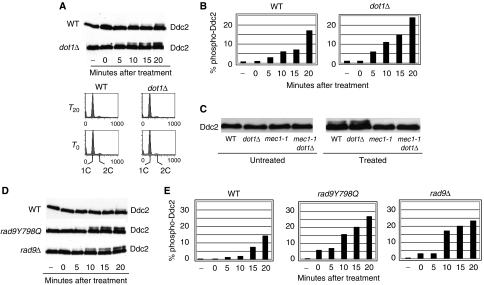Figure 1.
Loss of DOT1 or RAD9 leads to Mec1 kinase hyper-activation after induction of DSBs. (A) WT (YLL683.8/3b) and dot1Δ (YFL403/10b) cells carrying an HA-tagged version of DDC2 at its chromosomal locus were arrested in G1 and treated with 50 μg/ml zeocine to induce DSBs. At the indicated times (–: untreated cells) samples were taken, protein extracts were prepared and the phosphorylation-dependent mobility shift of Ddc2 in SDS–PAGE was monitored by western blotting with 12CA5 antibodies (top panels). FACS profiles of the cultures (bottom panels) show that both cultures did not escape the G1 block throughout the experiment. (B) Quantification of the percentage of phosphorylated form relative to the total Ddc2 protein (from (A)). (C) Ddc2 phosphorylation was monitored in WT (YFL693), dot1Δ (YFL694), mec1-1 (YFL219/9b), mec1-1 dot1Δ (YFL571.1) cells after treatment with zeocine, as in (A). (D) Western blots of Ddc2 in WT (YLL683.8/3b), rad9Y798Q (YFL502) and rad9Δ (YFL407/5a) cells, at different times after induction of DSBs. (E) Quantification of the bands from (D).

